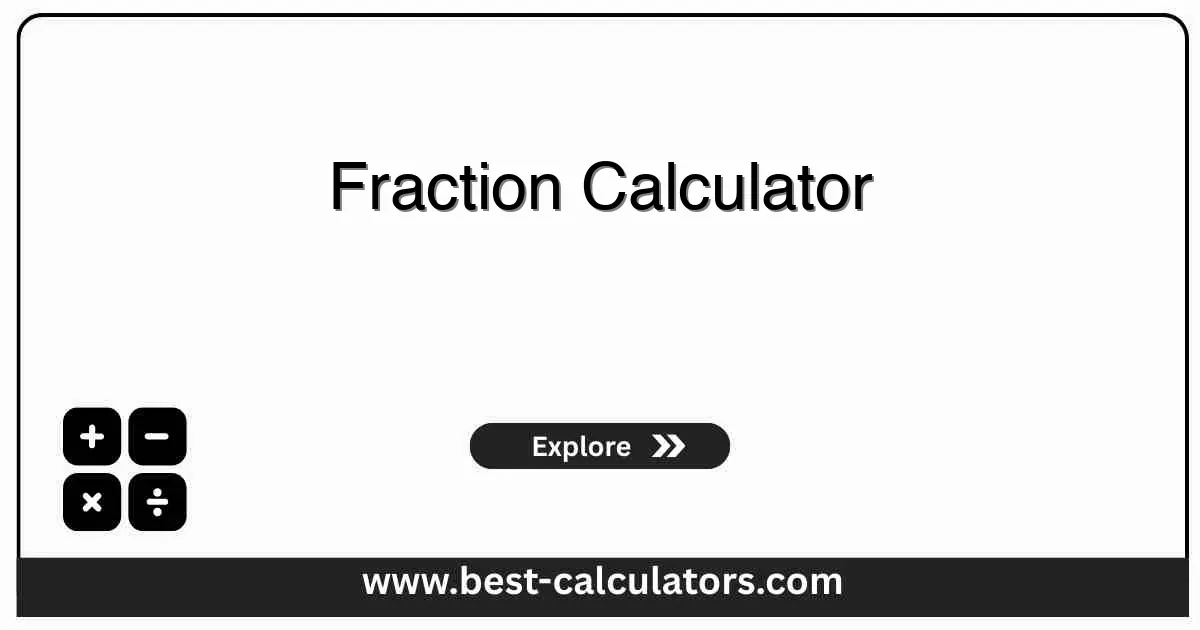Fraction Calculator - Add, Subtract, Multiply, Divide Fractions
Free fraction calculator to perform operations with fractions including addition, subtraction, multiplication, and division. Get step-by-step solutions
Fraction Calculator
Results
Common Examples
How to Use This Calculator
Select Operation
Choose the fraction operation you want to perform (add, subtract, multiply, or divide)
Enter Fractions
Input the numerators and denominators for both fractions
Calculate
Click the calculate button to get your result
View Results
See the result in fraction form, simplified form, and decimal form
Understanding Fractions
A fraction represents a part of a whole or, more generally, any number of equal parts. It consists of a numerator (top number) and a denominator (bottom number).
Parts of a Fraction
The numerator represents how many parts are being considered, while the denominator represents the total number of equal parts in the whole. For example, in 3/4, 3 is the numerator and 4 is the denominator.
Types of Fractions
Proper fractions have a numerator smaller than the denominator (e.g., 3/4). Improper fractions have a numerator greater than or equal to the denominator (e.g., 5/3). Mixed numbers combine a whole number with a proper fraction (e.g., 1 2/3).
Understanding Your Results
Your fraction calculation provides the result in multiple formats to help you understand and use the value in different contexts.
Fraction Result
The primary result is displayed as a fraction in its original form after performing the operation.
Simplified Form
The fraction is reduced to its simplest form by dividing both numerator and denominator by their greatest common divisor.
Decimal Form
The decimal equivalent is provided for practical applications where decimal values are preferred.
Important Considerations and Limitations
While our fraction calculator provides accurate results, it's important to understand its limitations and consider the context of your calculations.
1. Zero Denominator
Fractions with a denominator of zero are undefined. The calculator will show an error message if you attempt to divide by zero.
2. Negative Values
The calculator handles negative fractions correctly. Remember that a negative sign in front of a fraction applies to the entire fraction.
3. Precision
Decimal results are rounded to a reasonable number of decimal places for readability. For exact values, use the fraction forms.

Frequently Asked Questions (FAQ)
Q: What is a fraction calculator?
A: A fraction calculator is a tool that helps you perform mathematical operations with fractions, including addition, subtraction, multiplication, and division. It can also simplify fractions and convert between mixed numbers and improper fractions.
For converting decimals to percentages, you can use our decimal to percent converter.
To calculate percentage changes between values, try our percentage change calculator.
For temperature conversions between different units, our temperature converter is an excellent tool.
Q: How do you add fractions?
A: To add fractions, first find a common denominator. Then add the numerators while keeping the denominator the same. Finally, simplify the result if possible. For example, to add 1/4 + 1/6: Find a common denominator (12), convert fractions (3/12 + 2/12), add numerators (5/12), and simplify if needed.
Q: How do you multiply fractions?
A: To multiply fractions, multiply the numerators together and multiply the denominators together. Then simplify the result if possible. For example, to multiply 2/3 × 3/4: Multiply numerators (2×3=6) and denominators (3×4=12) to get 6/12, then simplify to 1/2.
Q: How do you divide fractions?
A: To divide fractions, multiply the first fraction by the reciprocal of the second fraction. The reciprocal is obtained by swapping the numerator and denominator. For example, to divide 2/3 ÷ 1/4: Multiply 2/3 × 4/1 = 8/3.
Q: How do you simplify fractions?
A: To simplify a fraction, find the greatest common divisor (GCD) of the numerator and denominator, then divide both by the GCD. For example, to simplify 12/18: The GCD of 12 and 18 is 6, so divide both by 6 to get 2/3.
Q: What are mixed numbers and improper fractions?
A: A mixed number consists of a whole number and a proper fraction (e.g., 2 1/2). An improper fraction has a numerator greater than or equal to its denominator (e.g., 5/2). You can convert between these forms: 2 1/2 = 5/2 as an improper fraction.